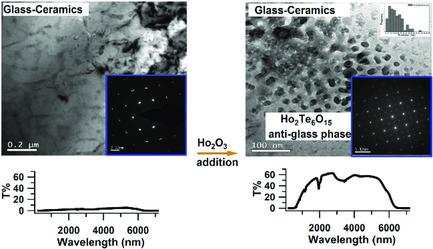当前位置:
X-MOL 学术
›
Adv. Eng. Mater.
›
论文详情
Our official English website, www.x-mol.net, welcomes your feedback! (Note: you will need to create a separate account there.)
Influence of Ho2 O3 on Optimizing Nanostructured Ln2 Te6 O15 anti -glass Phases to Attain Transparent TeO2 -based Glass-ceramics for Mid-IR Photonic Applications
Advanced Engineering Materials ( IF 3.6 ) Pub Date : 2020-04-17 , DOI: 10.1002/adem.201901357 Gaurav Gupta 1 , Sandip Bysakh 2 , Sathravada Balaji 1 , Sultan Khan 1 , Kaushik Biswas 1 , Amarnath R. Allu 1 , Kalyandurg Annapurna 1
Advanced Engineering Materials ( IF 3.6 ) Pub Date : 2020-04-17 , DOI: 10.1002/adem.201901357 Gaurav Gupta 1 , Sandip Bysakh 2 , Sathravada Balaji 1 , Sultan Khan 1 , Kaushik Biswas 1 , Amarnath R. Allu 1 , Kalyandurg Annapurna 1
Affiliation

|
The transparent TeO2‐based glass‐ceramics (GCs) have yet to achieve the breakthrough in photonic technologies, because of poor understanding in optimizing the growth of nanostructured crystalline phases. In the present investigation, the size effect of phase‐separation‐induced, nanostructured Ln2Te6O15‐based (Ln: Gd, Ho) “anti‐glass” phase in Ho2O3‐modified TeO2‐based TTLG (in mol%, 80TeO210TiO25La2O35Gd2O3) glass has considered to achieve transparent GCs. Raman study of TTLG glass reveals the presence of TeO3, TeO3 + 1, and TeO4 units with average TeO coordination number as 3.49. The formation of nanostructured Ln2Te6O15 phases in GCs is confirmed by X‐ray diffraction (XRD) and transmission electron microscopy (TEM) analysis. Furthermore, TEM analysis confirms that an increase of Ho2O3 concentration has reduced the size of phase‐separated domains in nanoscale with superstructure formation to attain transparent GCs. The superiority of this obtained transparent GCs as photonic material for near‐IR (NIR) to mid‐IR (MIR) range has been established by the realization of enhanced luminescence intensities and bandwidth at ≈2900 nm (Ho3+: 5I6 → 5I7) and ≈2050 nm (Ho3+: 5I7 → 5I8). This study offers an opportunity to fabricate the various accessible lanthanide ions‐doped and/or co‐doped TTLG glass with control over nanostructure, to design a series of GCs which are transparent from visible to MIR range.
中文翻译:

Ho2 O3 对优化纳米结构 Ln2 Te6 O15 抗玻璃相的影响,以获得用于中红外光子应用的透明 TeO2 基微晶玻璃
由于对优化纳米结构晶相的生长缺乏了解,透明的 TeO2 基玻璃陶瓷 (GC) 尚未在光子技术方面取得突破。在本研究中,相分离诱导的纳米结构 Ln2Te6O15 基(Ln:Gd,Ho)“抗玻璃”相在 Ho2O3 改性的 TeO2 基 TTLG(以 mol% 计,80TeO210TiO25La2O3 5Gd2O3)玻璃已经考虑实现透明GC。TTLG 玻璃的拉曼研究表明存在 TeO3、TeO3 + 1 和 TeO4 单元,平均 TeO 配位数为 3.49。X 射线衍射 (XRD) 和透射电子显微镜 (TEM) 分析证实了 GC 中纳米结构的 Ln2Te6O15 相的形成。此外,TEM 分析证实,Ho2O3 浓度的增加减小了纳米级相分离域的尺寸,并形成了超结构,从而获得了透明的 GC。通过在 ≈2900 nm (Ho3+: 5I6 → 5I7) 和 ≈ 实现增强的发光强度和带宽,确立了这种获得的透明 GC 作为近红外 (NIR) 至中红外 (MIR) 范围光子材料的优越性2050 nm (Ho3+: 5I7 → 5I8)。该研究提供了制造各种可接近的镧系离子掺杂和/或共掺杂 TTLG 玻璃并控制纳米结构的机会,以设计一系列从可见光到 MIR 范围透明的 GC。通过在 ≈2900 nm (Ho3+: 5I6 → 5I7) 和 ≈ 实现增强的发光强度和带宽,确定了这种获得的透明 GC 作为近红外 (NIR) 至中红外 (MIR) 范围的光子材料的优越性2050 nm (Ho3+: 5I7 → 5I8)。该研究提供了制造各种可接近的镧系离子掺杂和/或共掺杂 TTLG 玻璃并控制纳米结构的机会,以设计一系列从可见光到 MIR 范围透明的 GC。通过在 ≈2900 nm (Ho3+: 5I6 → 5I7) 和 ≈ 实现增强的发光强度和带宽,确立了这种获得的透明 GC 作为近红外 (NIR) 至中红外 (MIR) 范围光子材料的优越性2050 nm (Ho3+: 5I7 → 5I8)。该研究提供了制造各种可接近的镧系离子掺杂和/或共掺杂 TTLG 玻璃并控制纳米结构的机会,以设计一系列从可见光到 MIR 范围透明的 GC。
更新日期:2020-04-17
中文翻译:

Ho2 O3 对优化纳米结构 Ln2 Te6 O15 抗玻璃相的影响,以获得用于中红外光子应用的透明 TeO2 基微晶玻璃
由于对优化纳米结构晶相的生长缺乏了解,透明的 TeO2 基玻璃陶瓷 (GC) 尚未在光子技术方面取得突破。在本研究中,相分离诱导的纳米结构 Ln2Te6O15 基(Ln:Gd,Ho)“抗玻璃”相在 Ho2O3 改性的 TeO2 基 TTLG(以 mol% 计,80TeO210TiO25La2O3 5Gd2O3)玻璃已经考虑实现透明GC。TTLG 玻璃的拉曼研究表明存在 TeO3、TeO3 + 1 和 TeO4 单元,平均 TeO 配位数为 3.49。X 射线衍射 (XRD) 和透射电子显微镜 (TEM) 分析证实了 GC 中纳米结构的 Ln2Te6O15 相的形成。此外,TEM 分析证实,Ho2O3 浓度的增加减小了纳米级相分离域的尺寸,并形成了超结构,从而获得了透明的 GC。通过在 ≈2900 nm (Ho3+: 5I6 → 5I7) 和 ≈ 实现增强的发光强度和带宽,确立了这种获得的透明 GC 作为近红外 (NIR) 至中红外 (MIR) 范围光子材料的优越性2050 nm (Ho3+: 5I7 → 5I8)。该研究提供了制造各种可接近的镧系离子掺杂和/或共掺杂 TTLG 玻璃并控制纳米结构的机会,以设计一系列从可见光到 MIR 范围透明的 GC。通过在 ≈2900 nm (Ho3+: 5I6 → 5I7) 和 ≈ 实现增强的发光强度和带宽,确定了这种获得的透明 GC 作为近红外 (NIR) 至中红外 (MIR) 范围的光子材料的优越性2050 nm (Ho3+: 5I7 → 5I8)。该研究提供了制造各种可接近的镧系离子掺杂和/或共掺杂 TTLG 玻璃并控制纳米结构的机会,以设计一系列从可见光到 MIR 范围透明的 GC。通过在 ≈2900 nm (Ho3+: 5I6 → 5I7) 和 ≈ 实现增强的发光强度和带宽,确立了这种获得的透明 GC 作为近红外 (NIR) 至中红外 (MIR) 范围光子材料的优越性2050 nm (Ho3+: 5I7 → 5I8)。该研究提供了制造各种可接近的镧系离子掺杂和/或共掺杂 TTLG 玻璃并控制纳米结构的机会,以设计一系列从可见光到 MIR 范围透明的 GC。



























 京公网安备 11010802027423号
京公网安备 11010802027423号